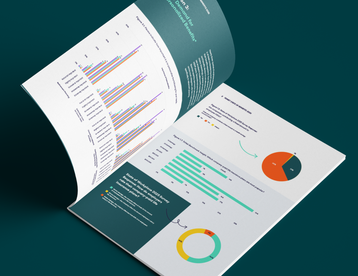How Employees Approach Benefit Elections—And What Small Business Can Learn

Table of contents
- 1.Predictability over savings
- 2.The power of momentum
- 3.Generational nuances in benefits behavior
- 4.Lessons for small businesses
- 5.Simplify the decision process
- 6.Personalize communication by relevancy
- 7.Pair HDHPs with support tools
- 8.Track emerging trends
- 9.The strategic advantage for small business
- 10.Conclusion
Employee benefits are no longer a passive checkbox at open enrollment. They are a strategic decision-making process—one that reveals how employees view budgets and healthcare priorities,. The State of Small Business Employee Benefits 2025 report* from TriNet provides a detailed look at employees’ benefit decisions and what that can mean for small and medium-sized businesses (SMBs).
The results may suggest a theme: employees may value financial predictability and simplicity over complex cost calculations. In practice, this suggests that most workers may prefer stable premiums, stick with past choices, and are hesitant to dive into the weeds of plan comparisons. For small business leaders, understanding these tendencies isn’t just an academic exercise—it can be the foundation for building benefit strategies that attract and retain top talent.
Predictability over savings
One notable survey result is that 72% of employees report preferring plans with lower out-of-pocket costs, even if the premiums are higher.
At first glance, this might seem counterintuitive. Why would employees knowingly choose to pay more upfront? Human psychology offers helpful insight into this. Unexpected medical bills are stressful and can derail household budgets. By choosing plans with higher premiums, employees may gain greater peace of mind and financial stability due to more predictable out-of-pocket costs, though individual benefits use may vary based on personal health needs and usage.
For SMBs, this preference carries two key implications:
- Emphasize stability in communication
Rather than focusing solely on costs, employers should highlight how certain plans help make out-of-pocket costs more predictable and potentially reduce costly unexpected expenses. - Balance plan design with risk management
Offering only high-deductible health plans (HDHPs) may not align with the majority preference. Traditional PPOs and HMOs remain popular because they can deliver value. If a small business wants to introduce HDHPs, pairing them with strong employer contributions to HSAs or FSAs can soften the financial uncertainty and enhance election rates.
For many employees, knowing when coverage actually begins is just as important as what the plan covers. Questions like how soon after starting a job do benefits kick in highlight the need for clear communication during onboarding.
The power of momentum
Another important behavioral insight is that 42% of employees simply roll over last year’s benefits. Only 15% actively seek out the most cost-effective plan.
This “benefits inertia” can be both a challenge and an opportunity for small businesses:
- The challenge: Employees may not be optimizing their benefit elections. They could be paying for coverage that doesn’t align with their current needs or overlooking new voluntary benefits that could better support them. That can lead to frustration if they later discover options that align with their needs were available.
- The opportunity: Employers have an opportunity to support employees in making informed decisions by offering decision support tools. Since many employees tend to accept the status quo, easily accessible and user-friendly tools may help them to consider more balanced or beneficial choices that meet their needs.
Generational nuances in benefits behavior
While the broad patterns apply across the workforce, the State of Small Business Employee Benefits 2025 report also reveals generational differences that small businesses should pay attention to:
- Millennials (born 1981–1996):They appear to have a slight preference for more comprehensive coverage, with 26% reporting that they choose the option with the most coverage every year for medical, compared to 18% and 22% in other generations. For small businesses, this means positioning robust coverage options as a possibility to attract and retain Millennials—a critical factor given this group makes up the largest segment of today’s workforce.
- Gen Z (born 1997–2012): Shows a slight preference for exploring non-traditional voluntary benefits like pet insurance or identity theft protection. SMBs can offer voluntary options to help attract talent. Certain employees may be more receptive to non-traditional perks, from pet insurance to commuter benefits, which can reflect a company’s support for flexibility and evolving lifestyle needs.
- Baby Boomers (born 1946–1964): Interestingly, Baby Boomers seem to lead in demand for personalization across many benefit categories. This suggests that communications and offering options like retirement planning or wellness programs could help retain talent.
These insights can help small businesses reflect on how their offerings align with employee needs. Sometimes, it may just be about presenting existing benefits in a way that better resonates with what employees may value.
Lessons for small businesses
So what does all of this mean in practice? Here are insights for small businesses to consider:
1. Simplify the decision process
Employees are signaling that they don’t want to overthink benefits. Employers should streamline enrollment with:
- Clear plan comparison tools that can provide details and compare the plan options.
- Decision-support tools that recommend plans based on lifestyle or usage patterns input by the employee.
- Easy-to-understand explanations of plans, coverage and deductibles.
2. Personalize communication by relevancy
Consider targeted benefit communications. For example:
- Highlight financial wellness options.
- Promote unique voluntary benefits.
- Showcase retirement and personalization options.
3. Pair HDHPs with support tools
Since 19% of employees choose HDHPs, small businesses shouldn’t expect rapid adoption without education and incentives. Providing employer contributions to HSAs, financial literacy workshops, or real-life cost scenarios can help employees see the potential short and long-term value.
4. Track emerging trends
Employees across generations are showing interest in mental health, telehealth, and bariatric care. These priorities signal an emphasis on holistic, accessible healthcare. SMBs that adopt or expand these offerings early may stand out as forward-thinking employers.
Small businesses must also balance employee preferences with requirements. Staying informed about employee benefits compliance helps ensure benefit packages remain both competitive and compliant.
The strategic advantage for small business
Ultimately, understanding employee behavior around benefits isn’t just about reducing frustration during open enrollment. It’s about positioning benefits as a strategic differentiator in talent acquisition and retention.
For small businesses, where budgets are often tighter than in large enterprises, the key is not to match every benefits dollar for dollar but to align offerings with what employees may value. That can mean:
- Providing comprehensive healthcare options.
- Communicating with employees in ways that are more likely to resonate with them.
- Offering voluntary benefits that align with employee expectations.
When small businesses align with employees where they are, in their preference, and their tendency toward inertia and their priorities, they can transform benefits from a cost center into a competitive advantage.
Conclusion
The State of Small Business Employee Benefits 2025 suggests that employee decision-making isn’t always focused on the economics—it’s human. Employees surveyed prefer security over potential savings, familiarity over optimization, and simplicity over complex comparisons.
For small businesses, this creates an opportunity: align benefits with employee behavior in mind, not against it. By leaning into preferences, personalization, and tailored communication, small businesses can turn benefits into a powerful tool for attraction and retention.
As the benefits landscape grows more complex, businesses that successfully attract and retain talent will be those that understand a simple truth: employees aren’t just looking for more choices—they are looking for confidence in the decisions they make. And when employers help build that confidence, it can be a win for everyone.
This article is for informational purposes only, is not legal, tax or accounting advice, and is not an offer to sell, buy or procure insurance. It may contain links to third-party sites or information for reference only. Inclusion does not imply TriNet’s endorsement of or responsibility for third-party content.

TriNet Team
Table of contents
- 1.Predictability over savings
- 2.The power of momentum
- 3.Generational nuances in benefits behavior
- 4.Lessons for small businesses
- 5.Simplify the decision process
- 6.Personalize communication by relevancy
- 7.Pair HDHPs with support tools
- 8.Track emerging trends
- 9.The strategic advantage for small business
- 10.Conclusion






